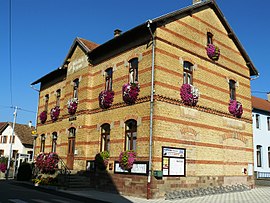You can help expand this article with text translated from the corresponding article in French. (December 2008) Click [show] for important translation instructions.
|
Mussig
Müssig | |
|---|---|
 The town hall in Mussig | |
| Coordinates: 48°13′46″N 7°31′15″E / 48.2294°N 7.5208°E | |
| Country | France |
| Region | Grand Est |
| Department | Bas-Rhin |
| Arrondissement | Sélestat-Erstein |
| Canton | Sélestat |
| Intercommunality | Sélestat |
| Government | |
| • Mayor (2020–2026) | Philippe Wotling[1] |
| Area 1 | 11.73 km2 (4.53 sq mi) |
| Population (2021)[2] | 1,139 |
| • Density | 97/km2 (250/sq mi) |
| Time zone | UTC+01:00 (CET) |
| • Summer (DST) | UTC+02:00 (CEST) |
| INSEE/Postal code | 67310 /67600 |
| Elevation | 167–174 m (548–571 ft) |
| 1 French Land Register data, which excludes lakes, ponds, glaciers > 1 km2 (0.386 sq mi or 247 acres) and river estuaries. | |
Mussig is a commune in the Bas-Rhin department in Alsace in north-eastern France.[3] Successive known names carried by the village were: Moussich, Mosich (1370) and Musich (1453) before becoming Musselburgh. The etymological origin is probably to be found in the existence of wetlands and swamps are conducive to the formation of foam. Until the 19th century[clarification needed] was practiced widely growing flax and hemp, woven at home or delivered to the weavers in the valley of Sainte-Marie-aux-Mines, this is still in the early twentieth century.
- ^ "Répertoire national des élus: les maires". data.gouv.fr, Plateforme ouverte des données publiques françaises (in French). 9 August 2021.
- ^ "Populations légales 2021" (in French). The National Institute of Statistics and Economic Studies. 28 December 2023.
- ^ INSEE commune file



